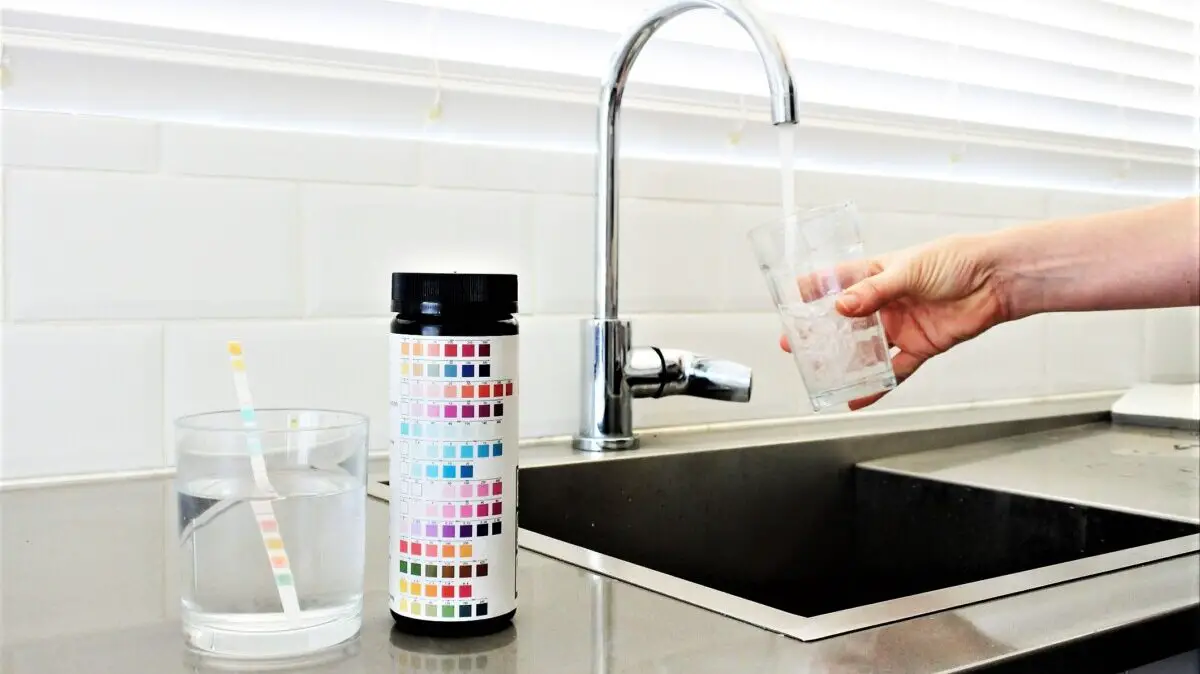Even in small quantities, drinking water contaminated with lead is harmful to our health. In fact, lead is so toxic that the Environment Protection Agency (EPA) has set the amount of lead allowed in drinking water to zero.
We can’t taste, smell or see the lead in our drinking water. The only way to know if lead is in your drinking water is to have it tested. DIY test kits are available, but certified laboratory tests are more reliable and accurate.
This article will provide you with information on what exactly lead is and why it is so harmful. We explain in detail how to know if there is lead in your water is and talk about how you can get rid of it.
- Lead is odorless, colorless and tasteless.
- Certified laboratory tests or DIY test kits can be used to check for lead in drinking water supplies.
- Information about lead (and other contaminants) in your water can be obtained from a consumer confidence report from the EPA.
Lead In our Drinking Water
Lead is found naturally in rocks, but only in small amounts. It’s a very soft metal but it’s also very dense, so it’s known as a ‘heavy metal’.
It’s in our air, soil, and water – almost everywhere. Although, most of our exposure to lead is because of human activities, like from when we used to use leaded gasoline (in the past), or manufacturing, and even painting.
Thankfully, the use of lead in everyday products, like gasoline and paint, is rare these days.
Exposure to high levels of lead or even low levels for a long time can have severe effects, including memory loss, constipation, kidney and brain damage. Too much lead in our body can eventually lead to death.
So, how does such a toxic metal find its way into your drinking water?
The most common sources of lead in tap water are lead pipes, water lines, household plumbing fixtures, faucets, fittings, and solder. In America, millions of us still get our drinking water from lead pipes, which has ultimately caused many of us (or our children) health problems.
Today there are regulations against using lead-containing pipes and plumbing fixtures in plumbing systems. Unfortunately, many houses built in the early 1900’s still have lead components in their plumbing systems.
Even pipes made in recent times can contain up to 0.25% lead. These pipes are still considered legally “lead-free” by the EPA. This means you shouldn’t assume your drinking water is completely lead-free just because your house was built after the 20th century.
Lead often gets into our tap water from the corrosion (like rust) of these lead-containing pipes and plumbing fixtures. Air and slightly acidic water naturally corrode lead pipes. Corroded pipes then contaminate the water flowing through them.
How To Test For Lead In Water
While the government at all levels usually does its part to make sure lead is removed from your drinking water, most lead actually enters our water from the pipes in our own homes.
There are two reliable ways of checking if there is lead in your water: 1) Certified laboratory testing and 2) the Consumer Confidence Report from your utility provider.
1. Certified laboratory Kits

A certified lab test is the only way to know for sure if there is lead in your water, and how much – which is important. If lead concentrations are high then you’ll need to stop using the water immediately, whereas if it is only slightly elevated just using a water filter might be enough.
Having as much information as you can will help you decide what you should do about the lead in your water.
We recommend the Specialized Lead and Copper Water Test from mytapscore.com. This water test comes with all the materials you need to collect and submit samples for laboratory tests.
These tests are certified and use the official EPA method. The results include a detailed analysis of lead (and copper) in water.
There are also less accurate, but cheaper DIY test kits available on Amazon, like Safe Home’s test kit. These kits can still be valuable, they just provide less information than a lab test.
It’s also worth knowing that lead can come from dust, paint, soil, air, and food. Paying attention to these other aspects in your life gives you a broader perspective to help you eliminate lead health risks.
You can read more about how to remove lead from your air here.
2. Consumer Confidence Report

The EPA mandates every community water system to prepare and publish an annual water quality report. This report is called a Consumer Confidence Report (CCR) and contains a list of the names and quantities of all the contaminants in the water supplied to you.
If you’re connected to the public water system, you can contact your utility provider to send you a copy of the report generated that year.
Here is a link to the EPA’s website where you can search for the CCR of your area.
However, this will only provide you with information on the amount of lead in your water before it gets to your house, and also won’t help you if you use a domestic well. In fact, it also doesn’t account for the contaminants that can be introduced into your water as it flows through the pipes to get to you.
To know if pipes in your home are adding lead to your water, or if you use a well for your drinking water you will need to a certified lab test.
Using Lead-Contaminated Water
Because our skin can’t absorb lead, it’s safe to bathe or shower in lead-containing water. However, using lead-contaminated water to cook, brush teeth, or drink poses several health risks, such as organ failure, memory loss, and gastrointestinal diseases, and should be avoided.
Drinking water with lead in it is clearly hazardous.
Once lead enters our body, it progressively causes damage. It can be stored in bones and then released over time as our bones demineralize later in life.
The earlier you detect lead in water, the better for your long-term health.
How to Remove Lead From Water
If you’ve confirmed that there’s lead in your water, you don’t have to worry. There are now a number of water-purification technologies that can remove lead from your drinking water.
There are several water filter pitchers and filter bottles that are very effective in removing lead from your tap water.
Water Purification Guide has a complete breakdown of all the water filter pitchers that can remove lead available here.
You can also effectively remove lead from your water using a reverse osmosis system – read more about that here, and even some under-sink filters can remove lead.
But it’s important to know that boiling water doesn’t reduce or remove lead from water. In fact, boiling might actually increase the concentration of lead in the water, making it even more dangerous to drink. It can become more concentrated as the water evaporates as steam.
Flushing your tap water or line also doesn’t help remove lead. Although it’s always best to flush your tap by running your tap for a few moments before drinking the water, as it increases your chances of obtaining clean water.
However, this does not guarantee lead-free water. Only using a lead-removing water filter can remove lead from your water.
